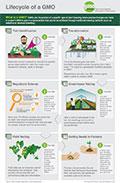Question
Answer
Expert response from Community Manager
Moderator for GMOAnswers.com
Tuesday, 07/07/2015 09:37
There are a few different ways to answer your question. “GMOs” - genetically modified organisms – in agriculture are plants developed through a process in which a copy of a desired gene or selection of genetic material from one plant or organism is placed in another plant, or a specific gene is “turned off” to achieve some benefit. In the United States, there are only ten GMO crops commercially available:
- Corn (field and sweet)
- Papaya
- Canola
- Cotton
- Alfalfa
- Sugar beets
- Summer squash
- Apple (approved to be grown, but not yet available in stores)
- Potato (approved to be grown, but not yet available in stores)
Other types of GMOs that are not plants include microorganisms used to make cheese, beer and wine, and even insulin used as medicine for humans.
Those crops are genetically modified for specific reasons, to exhibit specific “traits.” Many people think GMOs are bigger than non-GM crops, or taste or feel different, but genetic engineering isn’t yet used to make crops grow bigger or to look any different than their non-GM counterparts. The traits GMOs are created to exhibit include:
- Insect resistance. This trait provides farmers with season-long protection against target pests, reduces the need for pesticide applications, and lowers input costs.
- Drought resistance. GM crops that express drought resistance can grow in much drier areas, conserving water and other environmental resources.
- Herbicide tolerance. Crops that can tolerate specific herbicides allow farmers to fight weeds by applying herbicides only when needed and enable them to use no-till production methods that preserve topsoil, prevent erosion, and reduce carbon emissions.
- Disease resistance. Through genetic modification, the Hawaiian papaya industry was able to recover from the devastating papaya ringspot virus that had crippled the industry.
- Increased/enhanced nutritional content. Currently in development are genetically modified soybeans with an enhanced oil profile, much like olive oil, made to be longer lasting and trans fat free.

Genetic engineering is just one way to modify the genetics of a plant. This infographic outlines different methods of plant breeding. Humans have been modifying the genetics of plants and animals for more than 10,000 years, beginning with selecting for desired traits.
Learn more about plant breeding methods here.
If you’re interested in learning more about how a GM plant is made, check out these responses from Bobby Williams, senior research manager at DuPont Pioneer, and Patrick Walker, associate scientist at BASF Plant Sciences.
